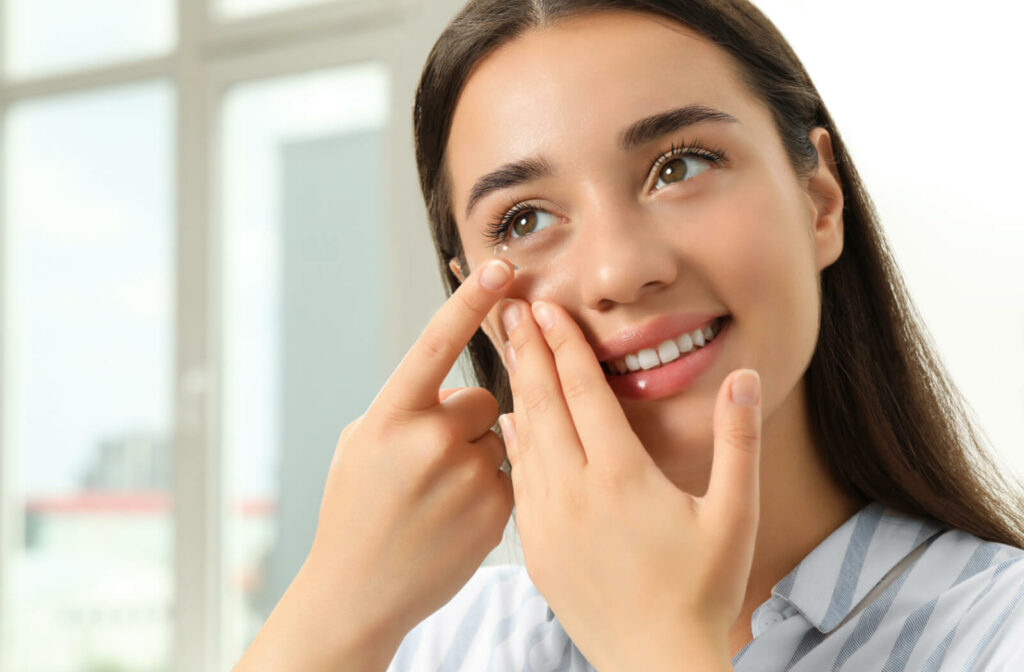Myopia, also known as nearsightedness, is a condition that affects an increasing number of people worldwide. It is caused by the elongation of the eyeball, which leads to blurred vision at a distance.
Although prescription eyeglasses and contact lenses have long been recommended remedies for this condition, they do not address the underlying problem of eye elongation. Myopia control contact lenses are specifically designed to help slow the progression of myopia by reducing eye growth.
The options for myopia control contact lenses include multifocal contact lenses—also known as peripheral defocus contact lenses—and orthokeratology (ortho-k) contact lenses. In some cases, atropine eye drops can also be used to help control myopia.
Understanding Myopia
Before getting into the corrective options for myopia, it is important to understand this refractive error. Myopia, or nearsightedness, is a refractive error that causes distant objects to appear fuzzy. It occurs when the shape of your eye causes light to focus in front of, rather than on, your retina, the light-sensitive layer of tissue at the back of your eye.
The following are some of the most prevalent signs of nearsightedness:
- Having difficulty seeing distant objects clearly
- Squinting to see clearly
- Headaches
- Eye strain
- Trouble playing sports
- Sitting too close to the TV
Multifocal Contact Lenses (Peripheral Defocus Contact Lenses)
Peripheral defocus contact lenses are multifocal contact lenses designed with different prescription zones, similar to multifocal eyeglasses. The prescription zone at the edge is designed to blur peripheral vision, while the zone in the center is designed to provide clear vision.
By blurring peripheral vision, these lenses can help slow and reduce eye growth to provide more control over myopia. Multifocal contact lenses can be worn daily and may be ideal for those who spend a lot of time reading, writing, or using electronic devices.
Multifocal lenses are often recommended for those who prefer daily wear lenses and want a continuous myopia control solution.
Orthokeratology (Ortho-K) Contact Lenses
Orthokeratology (ortho-k) contact lenses—also known as corneal reshaping contact lenses—are rigid gas-permeable lenses that are worn overnight to reshape the cornea. The lenses are designed to correct vision while also slightly flattening the cornea to help slow down the progression of myopia.
This option can be ideal for children who can wear contact lenses at night and don’t want to wear glasses or contact lenses during the day.
What Are the Other Types of Contact Lenses for Myopia?
There are several other types of contact lenses that can help you see clearly when your vision is affected by myopia. It’s important to remember that they are not typically designed for myopia control—just clear vision. However, you still need a proper contact lens fitting to get the right type for your eyes.
Soft Bifocal & Multifocal Contact Lenses
Soft bifocal and multifocal contact lenses are similar to multifocal contact lenses, but the distribution of vision correction varies. These soft contact lenses can offer multiple prescriptions in one lens and have varying correction profiles that are designed to provide clear vision at different distances.
The lenses can be worn for an extended period and may be ideal for those who need a change in vision correction as they age. They are designed for comfortable daily wear and may be a suitable option for those who find multifocal glasses uncomfortable.
Conventional Single-Vision Contact Lenses
Conventional single-vision (monovision) contact lenses correct only distance vision and offer no control of myopia progression. These lenses do not slow down the elongation of the eye, but they can still help those with myopia see clearly.
Soft Contact Lenses
Soft contact lenses are style designed for comfort. They may be suitable for a variety of lifestyles and visual needs but are not always designed for myopia control. It’s important to speak with your optometrist about the right soft contact lenses for your needs.
Rigid Gas-Permeable Contact Lenses (RGP Lenses)
RGP lenses can provide a rigid, durable option for clear vision. They can offer specific benefits for some visual needs and eye conditions, such as dry eyes, but it may take some time to adjust to using them. Ortho-k contact lenses are typically rigid lenses, but not all RGP lenses can help with myopia control.

What Are Atropine Eye Drops?
Atropine is a substance used by eye doctors to help dilate your eyes during eye exams. Some studies have shown that low-dose atropine drops may be beneficial for reducing the progression of myopia in children. Low-dose atropine eye drops may also be paired with other forms of myopia control, depending on your child’s needs.
Navigating the Myopia Control Contact Lens Landscape
Myopia control contact lenses are becoming increasingly popular due to their effectiveness in helping slow myopia progression, but it’s important to get the right lenses for your needs.
Embracing myopia control contact lenses can help enhance your child’s vision and contribute to the long-term health of their eyes. At Pack & Bianes Optometry, we can help you determine which myopia control contact lenses are right for your child based on their lifestyle, age, and vision needs. Book your appointment now!



